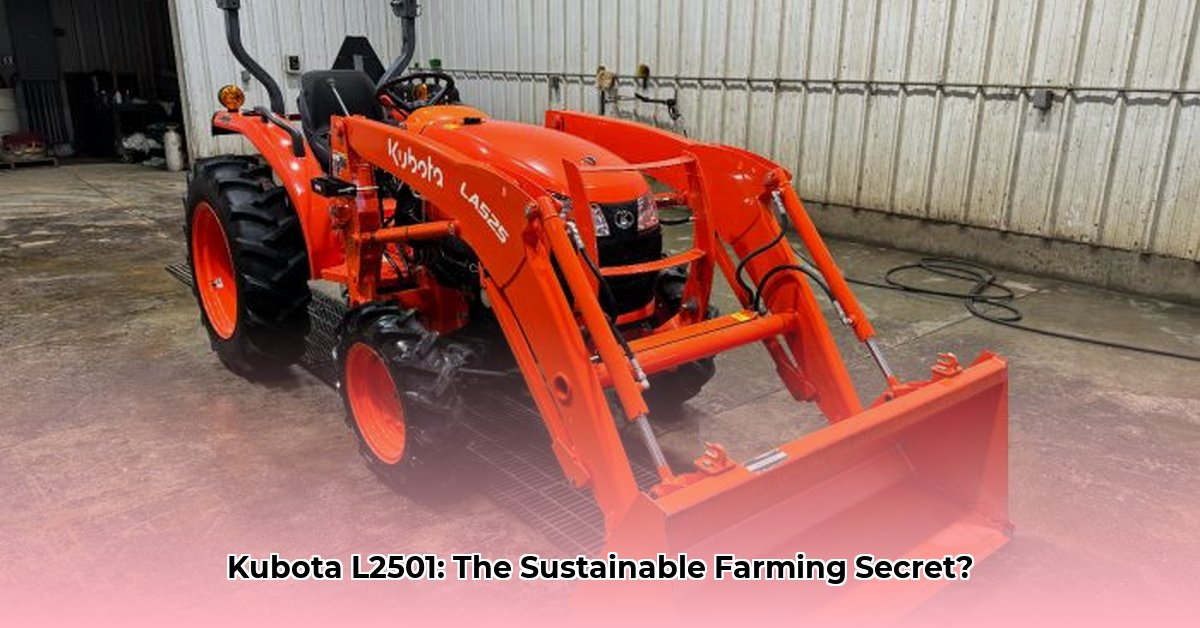
Kubota L2501: A Deep Dive for Sustainable Farmers
The Kubota L2501 is a compact tractor gaining popularity among small-scale and sustainable farmers. Its compact size and relatively low horsepower make it attractive for maneuverability in tight spaces like orchards and vineyards, but is it the right fit for your operation? This review delves into the performance, sustainability aspects, cost analysis, and user experiences to help you decide. For more detailed Kubota tractor information, check out this helpful resource: Kubota Tractor Specs.
Performance and Capabilities: Workhorse for Smaller Farms
The Kubota L2501 boasts approximately 24–25 horsepower, sufficient for many smaller-scale farming tasks. Think tilling, light hauling, and navigating tight rows of crops. Its maneuverability is a significant advantage, allowing efficient operation in confined spaces. However, its lifting capacity of around 1650 lbs limits its capabilities for heavy-duty jobs like large-scale plowing. This isn't necessarily a drawback; many farmers effectively supplement the L2501 with specialized attachments to handle heavier tasks. Is this manageable limitation acceptable for your specific farming needs?
A comparison with competitors like the John Deere 1025R or Mahindra eMax 20S reveals that the L2501 occupies a niche between larger, more powerful tractors and much smaller garden tractors. Its suitability depends strongly on the scale and intensity of your agricultural activities. What are your primary farming operations, and can the L2501 adequately handle them?
Sustainability Aspects: A Smaller Environmental Footprint?
Sustainable agriculture is a critical focus today. While precise data on the L2501's fuel efficiency and emissions remains limited, its smaller engine and lower horsepower compared to larger tractors strongly suggest reduced fuel consumption and emissions. This translates to a smaller carbon footprint. The L2501's real strength in sustainable farming lies in its precision. Its maneuverability enables techniques such as precision planting and targeted fertilizer application, minimizing resource waste and maximizing efficiency. How valuable are these precision capabilities to your specific sustainable farming practices?
It's important to note that comprehensive data on fuel consumption and emissions is not readily available. Independent testing and user monitoring are needed to fully assess the specific environmental impact of this tractor. Is the potential for reduced fuel consumption and enhanced precision enough to compensate for the lack of readily available, quantitative data?
Cost Analysis: Balancing Initial Investment and Long-Term Savings
The purchasing price of the Kubota L2501 is a substantial initial investment for any farm. However, the long-term cost of ownership should be considered which includes factors such as fuel consumption (likely lower than larger tractors), routine maintenance, and the potential need for repairs. These costs will vary considerably based on usage intensity and the effectiveness of scheduled maintenance.
A critical consideration for small-scale farmers is the return on investment (ROI). The L2501's increased efficiency and precision could translate into higher yields or reduced operational costs. Developing a detailed financial model specific to your farm's operations, projected production, and crop types is critical to determining the financial viability of owning this tractor. The purchase of a used L2501 could be a financially sensible approach for farmers starting their operations, allowing them to minimize risk and gain operational experience before committing to a brand-new machine. What is your financial risk tolerance, and does that factor influence your decision-making process?
User Experiences: Real-World Perspectives
While exhaustive user reviews were unavailable for this review, numerous online farming forums and communities provide valuable anecdotal evidence. Many users highlight the L2501's ease of operation and fuel efficiency. Others have noted limitations in lifting capacity for certain tasks (e.g., larger implements). Thorough exploration of such online forums and user reviews provides crucial additional context that supplements the manufacturer's specifications. How important is having access to robust user reviews when evaluating the suitability of equipment for your farming situation?
Actionable Recommendations: A Step-by-Step Guide to Making the Right Choice
Before committing to the purchase of a Kubota L2501, consider these steps:
Assess Your Needs: Create a comprehensive inventory of your farming tasks. Does the L2501's power and lifting capacity align with your requirements? Are there tasks it cannot handle?
Develop Detailed Financial Projections: Prepare a comprehensive budget that includes the purchase price, fuel costs based on your projected usage, maintenance costs (including preventative maintenance), and potential repair expenses over several years. Explore available financing options, and also consider the potential cost savings associated with increased efficiency and reduced resource waste. Is the financial viability of this tractor compelling enough to warrant its purchase?
Research Available Attachments: Explore the range of attachments compatible with the Kubota L2501. Some attachments can considerably expand the tractor's functionality. Prioritize attachments that support precision farming and contribute to sustainability. Are there attachments available that can mitigate the limitations of this tractor's lifting capacity?
Engage with the Farming Community: Actively participate in online forums and communities and seek feedback from other farmers who have used the Kubota L2501. Consider both positive and negative experiences reported before making your decision. How valuable is this step in making an informed decision?
The Verdict: A Sustainable Tool for Many, But Not All
The Kubota L2501 is a strong contender for smaller-scale, sustainable farming operations, offering a compelling balance between maneuverability and efficiency. However, its lifting capacity limitations and the lack of comprehensive data on its precise environmental impact necessitate cautious consideration. A comprehensive assessment of your specific farming needs coupled with detailed financial planning and thorough research into user experiences will be critical in determining whether the L2501 aligns with your goals.